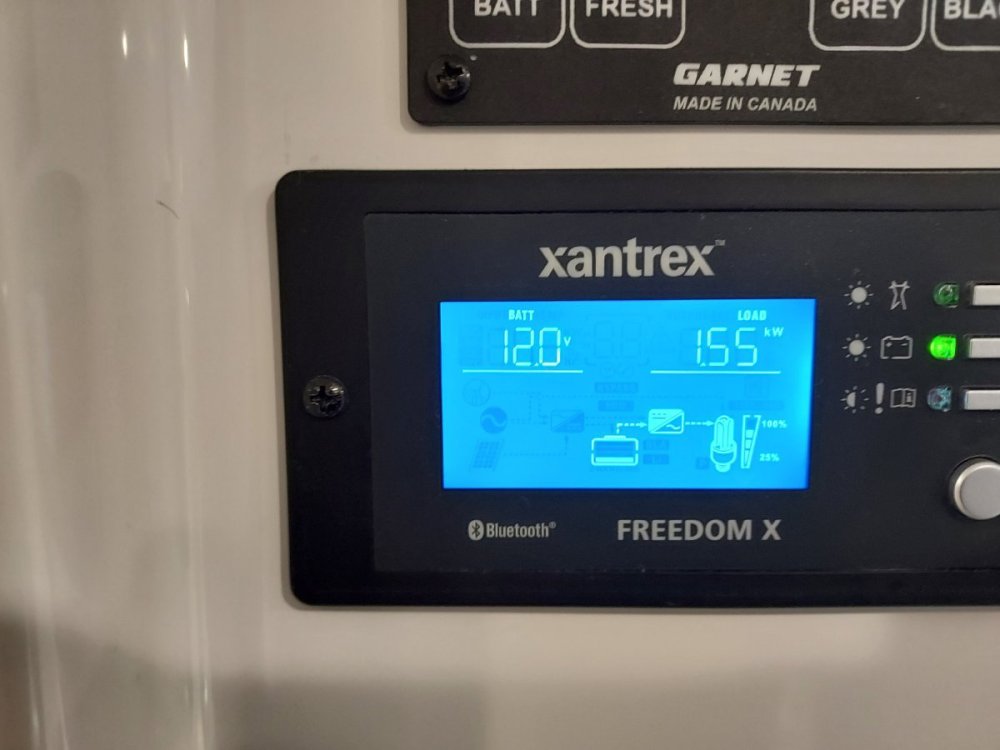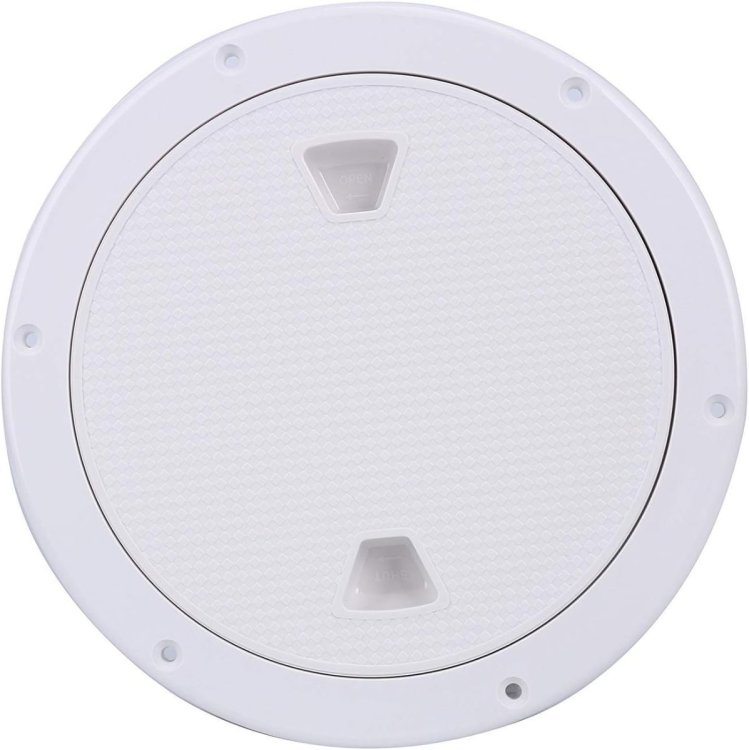-
Posts
806 -
Joined
-
Last visited
-
Days Won
16
Everything posted by Rivernerd
-
Your photo depicts the inverter wall-mounted remote in your 2022, not the actual inverter. The actual inverter is mounted under the the street side bed, aft of the pantry. Our 2022 Elite II has the same configuration.
-
We use our inverter regularly when boondocking. We have yet to use a generator, although we usually carry a pair. But, we also have 390 Ah of LiFePO4 batteries, which provide sufficient power to run 120V appliances (like the microwave or AC) for an hour or two. Cort, what battery package do you have? That may impact the feasibility of an inverter upgrade.
-
Then you would surely benefit from installation of an inverter to provide 120V power when boondocking. But, I expect adding an inverter is a fairly major upgrade after construction. Has anyone on this forum ever done it?
-
That is not your inverter remote control panel; it is your solar panel charging panel. Below is a photo of the Xantrex inverter control panel in our 2022 Elite II. The silver button in the lower right hand corner is the "on/off" switch. "In" is on, "out" is off. In the photo, the inverter is on (switch in the "in" position).
-
Our Hull #1291, 2022 Elite II, includes the Lithium Pro Package. Each of the 3 Lithionics G31 batteries has its own on/off switch. I see no need for a "master" DC cutoff switch with this package.
-
I concur. Just be sure that any external charger you buy is designed for lithium batteries, or has a "lithium" setting. Ordinary battery chargers work great for lead/acid batteries, but do not properly charge lithiums, which require higher charging voltage. That said, you still need to get your Xantrex Freedom Pro inverter/charger addressed so it will charge your battery bank as designed. Please post what you are advised to do by Oliver Service, in case others (like me) are faced with a similar problem in the future.
-
FYI, an upgrade to Lithium Iron Phosphate (LiFePO4) batteries would require many other upgrades as well, probably including some of the wiring in your trailer, and likely the inverter/charger. Although I am a LiFePO4 fan, such an upgrade does not make sense in your use case. You just need batteries to run your 12V systems in between shore power hookups. I recommend avoiding 12V Flooded Lead Acid (FLA) batteries (like the ones that come in most cars and trucks) because they require maintenance, and if too deeply discharged, can be permanently damaged. It would be worth the extra cost to me to get deep cycle Absorbed Glass Mat (AGM) marine batteries, as they are sealed, never leak, and do not require periodic checking and top-off. As I recall, the AGMs installed by Oliver were 6V wired to produce 12 Volts. If yours are 6V, it would be easiest to replace them with identically-sized 6V batteries, wired the same way. 12V batteries would require a different wiring configuration. I recommend you buy 6V batteries providing the same number of amp hours (Ah) you have had, if you can find the right ones that fit in your battery tray. If you only buy only one battery, you may have an unpleasant surprise if it is not adequate to power your 12V systems as long as the originals did. This can be significant, for example, if you run your fridge on DC while on the road between shore power stops. I second the recommendation to check out Batteries Plus. If you take the trailer to one of their retail locations, they have knowledgeable salespeople who can help ensure that your replacement batteries properly fit in your battery tray, that they can be secured using the factory tie-down straps, that the positive and negative battery posts match up with the locations of your "old" AGMs, etc., so the solution will hopefully be "plug and play." And, you can swap out your old AGMs right then to avoid the core charge on the new ones. They might even remove the old batteries and install the new ones for you. As an old guy with a bad back, that would be important to me, because AGMs, like FLAs, have lead/acid chemistry, so they are heavy! Good luck!
-
Do you have a larger 50-foot extension cord, perhaps 12-gauge, which would be rated for 20A? When I connect house power to our 2022 Elite II, I use a 10-gauge extension cord so there is no issue with delivery of at least the 20A provided to the receptacle by the 12-gauge wire on a 20A circuit in our house wiring. If I didn't own at least a 12-gauge extension cord, yet needed to connect my Elite II to house power some times, I would invest in one, or maybe even a 10-gauge. Also, be sure to submit a service ticket. Oliver Service has surely encountered this issue before.
-

elite 2 The wait
Rivernerd replied to Jason Foster's topic in Welcome To The Oliver Travel Trailer Forums
Lol. Sounds like something I would do. Then plan to do it! With a Tuesday delivery, I recommend you consider spending Tuesday-Thursday nights at David Crockett State Park in Lawrenceburg, then return to Hohenwald on Friday with your (hopefully short) list of issues to be addressed by the Oliver Service Department. Reserve a spot at the Oliver Service/Showroom facility for Friday night, as your Oliver may not be returned to you until the end of the day. If you have more time, plan to spend Tuesday night at Oliver Service, then Wednesday-Sunday at David Crockett State Park, returning to Hohenwald on Monday morning, if needed. We had a Thursday delivery, so we spent Friday-Sunday at the Park. I spent nearly all of those 3 days thoroughly inspecting and testing the Oliver inside and out, which left me too little time to really explore that beautiful state park. Once you finalize your plans, reserve a camp spot online. It is a popular park. We found that, even in November, most campsites were reserved many weeks in advance. The spots along Shoal Creek are the first ones reserved. Good luck! -

elite 2 The wait
Rivernerd replied to Jason Foster's topic in Welcome To The Oliver Travel Trailer Forums
You will received training on all of the systems in the trailer the day you take delivery. Although excellent, it is like "drinking from a fire hose." To get better prepared to absorb all of that important information, review all of the videos available online in Oliver University in the meantime, until you could "teach the class." Also, plan to spend at least 3 days after pickup inspecting the trailer and testing all of the systems. We live in Idaho, so we spent 3 days at David Crockett State Park (had to do that, as my middle name is Crockett) thoroughly inspecting and testing everything we could before beginning the return trip to the West. We found a few defects, which the Oliver Service Department jumped on immediately after we arrived back in Hohenwald. We considered their response exemplary. We took delivery on our Elite II exactly one year ago today, November 10, 2022. The Oliver Service Department has honored the 1-year warranty better than any company with whom I have ever dealt. And, although after expiration of the warranty Oliver is no longer responsible to pay for parts or labor, they will still provide valuable advice in response to a service ticket. I have particularly high regard for Jason Essary, Oliver's Service Manager. -
It appears that the two LiTime 230Ah batteries fit nicely in the Oliver battery tray. It also appears that 460 Ah of LiTime batteries (230x2) can be purchased for about $1400 ($700x2). This is less than 1/3 the price of 390 Ah of Lithionics batteries (130Ah x 3), at about $1450 each ($1450x3=$4350), which comprise the Lithium Pro Package included with our Elite II. I am interested in the long-term performance of the LiTime batteries, in case I have to ever replace our LIthionics batteries. 3x the price is quite a premium to pay for Lithionics "Assembled in the USA using domestic & imported components" vs.LiTime's "Made in China." Our Lithionics G31 batteries all have a sticker that reads: "County of Origin LIthium+Case CHINA."
-
The link below is for a 6" deck plate I bought last year to replace the one Oliver installed on the "doghouse." It is true white, and matches the Oliver fiberglass almost exactly. It is threaded, so the cover screws securely into the base. I am thinking of installing one where you installed your forward one, so I can access the plumbing valves without removing the bed. https://www.amazon.com/gp/product/B06ZZWYNVL/ref=ppx_yo_dt_b_search_asin_title?ie=UTF8&psc=1
-
I hope they are close to the same size as the touch lights. As our touch lights fail, I would love to replace them with switch-operated lights.
-
For about a year now, Oliver has been offering the Truma AC package on new units. Our Hull #1291 Elite II has the Truma air conditioner. It is much quieter than the standard Dometic. I don't know if it cools any better than the Dometic, but we used ours last August on a couple of 100 degree F days in direct sunlight at 4200 feet in Idaho. The Truma AC effectively cooled the cabin down to 75 degrees F, which is where we like it, and kept it there. I would not fear leaving pets in the trailer during ambient outside temps of 100 degrees F, with a Truma air conditioner running. Of course, you must have shore power or at least a 3KW generator to run the AC for more than an hour or two, even with the Lithionics batteries Oliver is now offering with new units.
-
Lest folks get confused when they go looking for "4" PVC," what you used is ABS. In the plumbing world, ABS is black, PVC is white. So, to replicate your clever mod, folks should buy a 4" ABS connector. The same fitting might be available in PVC, which would come in white. Lots easier than painting. The fitting you used in PVC might be this 4" PVC Sewer and Drain Adapter: https://www.lowes.com/pd/PVC-4-in-x-4-in-dia-PVC-Adapter-Fitting/3455246?user=shopping&feed=yes&srsltid=AfmBOoqiQKecE5I94QDhmh3FLnYQEu_e183jcC9ZSiT_t9vAn5YMpw4bqvE If I were trying to implement this mod, I would buy one of those, see if it fits, then return it if it doesn't, and buy more if it does.
-
Yep. Our Hull #1291 has a full-strip magnet which holds the door closed. We like it a lot.
-
Impressive. The documentation of your work is clear and easy to follow. It reminds me of similar posts from John Davies, which is high praise!
-
As is the bathroom door in our 2022 Elite II.
-

Using my OTT below freezing
Rivernerd replied to GeoffChapman's topic in Mechanical & Technical Tips
Don't leave your Truma water heater on when driving. Put it into antifreeze mode, with the the antifreeze unit installed and running. That is what it is for. You can then turn it to Eco or Comfort mode when you are off the road camping and need hot water. When we travel in cold weather,we still run our 3-way fridge on DC. This is to avoid driving into a gas station with the open flame that the fridge propane setting requires. If driving in temps below freezing when not winterized, I would leave the furnace running on propane at 65 degrees F or higher, to keep the plumbing from freezing. But, I would pull off the road outside any gas station and turn it off before refueling. I would then pull off the road again after leaving the gas station and turn the furnace back on. Think about what could happen if your furnace tried to ignite fuel while parked next to a gas pump. It would be like lighting a match! With this regimen, monitor your propane levels. Depending on the size or your tanks, you may run out of propane every 3-4 days. -
When towing our (then) new Elite II home to Idaho last November, we experienced freezing temps every night. As low as 9 degrees F one night. Like you, I placed a digital temperature monitor in that street side compartment near the outside faucet. I also placed digital monitors under the front dinette seat and in the closet (which did not yet have the air vents I installed after we returned home). The monitor in the compartment with the 3000 watt Xantrex inverter consistently reported the coldest temperatures of the three. The inverter operated only occasionally, such as when we first connected to shore power, having drawn down our Lithium Pro 390 Ah batteries somewhat during the travel day by running the fridge on DC. Even the night after we boondocked at a Harvest Host facility (so our batteries had two days of DC draw down without shore power recharge, just solar), I did not note a significant difference in the temperature reported in that aft street side compartment while the inverter was recharging the batteries from shore power. My conclusion from this data, collected over 5 cold nights, is that the amount of heat generated by the Xantrex Freedom Pro 3000 watt inverter is not sufficient to noticeably warm that aft street side compartment in freezing outside temps. For what its worth, with our Truma Varioheat furnace keeping cabin temps at about 70 degrees F overnight, none of the digital monitors reported temps lower than 35 degrees F, which was the one in that aft street side compartment the night ambient temps dropped down to 9 degrees F. So, the un-winterized plumbing in that yet-unmodified Elite II was not at risk at those temps.
-

Newbies taking the plunge - Are we missing anything
Rivernerd replied to Dennis and Melissa's topic in General Discussion
I am quite interested to learn if your Ford owner's manual refers to tongue weight rather than trailer weight when addressing weight distribution hitches. If it, in fact, refers to trailer weight, then in the event of an accident when towing your Oliver, your insurance company still has an opportunity to deny coverage based on failure to comply with the owners manual. I also don't like the idea of shifting load to the rear to reduce tongue weight. Trailers handle much better when loaded a bit tongue heavy (60% forward of the axles, 40% aft). A "6000 lb. LEII" should have tongue weight around 600 lbs. when properly loaded. I am much more comfortable loading the trailer a bit tongue heavy, and using the Andersen WD hitch. Finally, having now adjusted to the quirks of using the Andersen hitch after 1 year of ownership, I prefer the way our rig handles with it attached. So, I don't mind the minimal extra time and effort required to hook and unhook it. We "don't leave home without it." -
My poor word choice, Once the repair is complete, put the original fuse back in the fuse holder to complete the circuit.
-

Newbies taking the plunge - Are we missing anything
Rivernerd replied to Dennis and Melissa's topic in General Discussion
1/2 ton truck owners manuals do not address tongue weight, but trailer weight. My Tundra owners manual requires a weight distribution hitch if towing over 5000 lbs., period, regardless of how much of that is tongue weight. With your "6000 lb. LEII," you are still well advised to use a weight distribution hitch. And, a weight distribution hitch helps not only with sway, but with traction and turning control. Shifting some of the weight from the tow vehicle rear axle to the tow vehicle front axle makes turning more stable. -

Valve beneath right seat of dinette table
Rivernerd replied to Vector - Lanham's topic in Mechanical & Technical Tips
Oliver recommends against blowing out the plumbing system with air pressure. As mentioned by Geronimo John above, the best way to clear residual plastic shards is by removing and cleaning the pump filter and faucet aerators. Just carefully follow the Oliver winterization video using the "pink stuff" and your trailer will be ready for the coldest winter.





